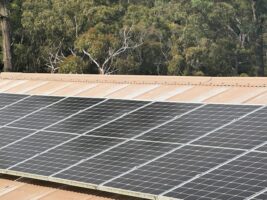New analysis of the performance of the Tesla big battery in South Australia suggests that distributed local battery and pumped hydro projects could offer better value to the grid than a single “monster” project like Snowy 2.0.
The analysis, from energy analyst Hugh Saddler, in his quarterly update of the National Electricity Market for The Australia Institute, will make a useful contribution to the debate over the future of storage in Australia.
The Tesla big battery, known as the Hornsdale Power Reserve, has impressed all observers since it was switched on in early December, with the notable exception of the federal government which wants instead to build the massive Snowy 2.0 pumped hydro project at a cost of $8 billion or more.
Saddler’s analysis confirms earlier reports – see our story Tesla big battery moves from show-boating to money-making – that its speed and flexibility allows it to intervene in high-priced events and “take the straw off the camel’s back.”
Already, the battery’s has eliminated significant price gouging in the small FCAS market, as we reported here. Premier Jay Weatherill confirmed this week that the Tela battery had “smashed” the gas cartel’s hold over the FCAS market, which provides network security.
Its influence on the bigger wholesale electricity market is less marked, because with only 30MW of capacity dedicated to arbitrage, it is still just clipping the peaks of a local grid that can consume up to 3,000MW or more at times of peak demand.
Still, Saddler says, its impact is clear.
“The graph shows a consistent pattern of charging up overnight, when prices are very low (well below $100 per MWh on all three days) and discharging in the late afternoon, when prices are very high ($8,000 per MWh between 4.00 and 4.30 pm local time on 7 February, which is 3.30 to 4.00 pm NEM time, as shown in Figure 11, somewhat lower on the other two days).”
Saddler notes that battery storage sceptics (yes, there is such a thing) often point out that 30MW is hardly more than 1 per cent of the peak demand of 2.9GW on 7 February.
“This is true, but not particularly relevant,” Saddler says.
“The Hornsdale battery is the first of its kind. Planning for a number of others in South Australia, Victoria and elsewhere is well underway.
“Since the capacity requirement for frequency control services is limited, it is almost certain that a number of subsequent battery projects will devote a larger proportion of their capacity to energy arbitrage.”
And, Saddler says, Hornsdale is clearly making the case for distributed storage.
“The experience of operating Hornsdale Power Reserve already demonstrates that multiple smaller energy storage facilities, which will certainly include both batteries and small pumped hydro projects, located close to wind and solar generators, are almost certainly better suited to matching variable supply with varying demand than a single monster project located a thousand kilometres or more away.” he says.
This is a clear reference to Snowy 2.0, which he also notes will only be able to deliver its service via multiple transmission lines “which often reach saturation capacity when demand for electricity reaches peak.”
Snowy Hydro has tried to turn the case for its big pumped hydro project into a battle between its project and battery storage. But its costings of battery storage have been contentious, see The case against Tesla and battery storage just hit peak stupid and so has its estimates of the value chain.
Note: Saddler also defended the AEMO and its Integrated System Plan Consultation, which has been used by critics to call for the closure of the key market institution.
“AEMO is required to think long term, and therefore to consider a wide range of possible futures, in order to do its job of managing the evolving electricity system,” Saddler notes.
You can see live updates of Neoen’s Hornsdale Power Reserve, as the Tesla big battery is know, on its home page here.











